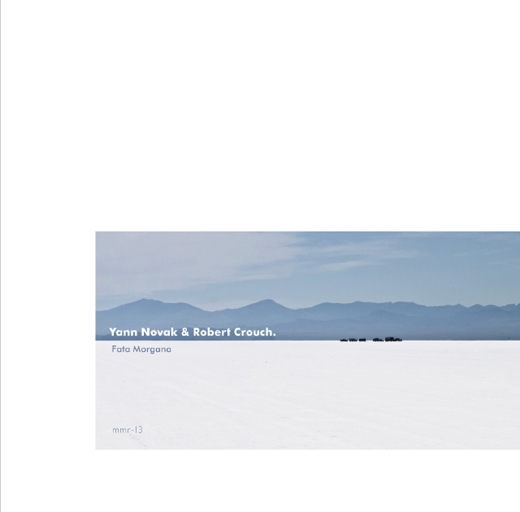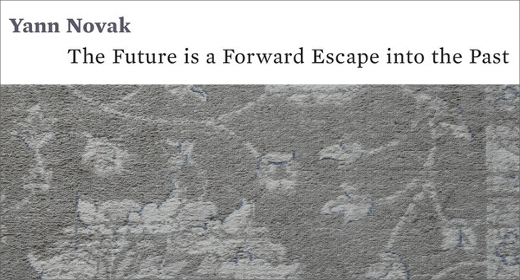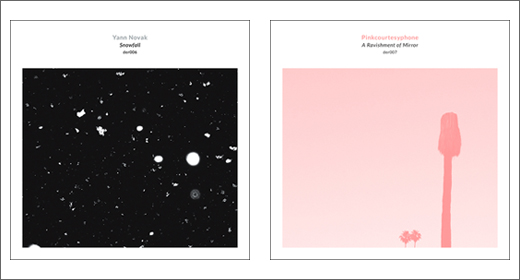The narrative pay-off is then clinched by the entry of filmic synth-strings, knowingly poignant affective signifiers, tension moving to resolution as it makes itself comfy with more familiar ambient tropes, seeking total tonal settlement.
 Yann Novak recently took time out from his Dragon’s Eye enterprise to explore more installation-based work. Through Japan’s Murmur we have a sample of one such here in Fata Morgana, a kind of reconstructed episodic travelogue mediated via video and audio field recordings using sound and multi-screen projection. Robert Crouch is roped in as fellow-traveller for what is described as a ‘digital take on traditional landscape painting’ that seeks ‘abstracted expressions of personal experiences.’ The title, for the uninitiated, refers to a phenomenon involving inversion of figure and ground boundaries over desert lands and seas effected by light refraction from a body of warm low-lying air reflecting images of distant objects the earth’s curvature would normally obscure.
Yann Novak recently took time out from his Dragon’s Eye enterprise to explore more installation-based work. Through Japan’s Murmur we have a sample of one such here in Fata Morgana, a kind of reconstructed episodic travelogue mediated via video and audio field recordings using sound and multi-screen projection. Robert Crouch is roped in as fellow-traveller for what is described as a ‘digital take on traditional landscape painting’ that seeks ‘abstracted expressions of personal experiences.’ The title, for the uninitiated, refers to a phenomenon involving inversion of figure and ground boundaries over desert lands and seas effected by light refraction from a body of warm low-lying air reflecting images of distant objects the earth’s curvature would normally obscure.
First performed in 2011 at Steve Roden-curated AxS Festival, Novak and Crouch’s Fata Morgana is a remote wispy embodiment of the eponymous mirage—an audio version recomposed for home listening. It sets out with programmatic intent, developing a sonic articulation of the figure-ground inversion by means of a high-low to’n’fro. A concomitant perceptual ambiguity is felt in shifts between chthonic and aerial sounds and dessicated sunblind sand-trickle rattle early on. A nocturnal hum spreads over desolate wind-blown heat-hazed plains, seeping through the interstices between field recording resonances (captured from Bonneville Salt Flats, Utah and Lake Mead in the Valley of Fire State Park, Nevada). Against this backdrop Novak’s signature drone-wash presence (cf. Presence) gradually takes on more conventional melodic electronica shadings from Crouch’s end—modular synth motifs, pulsations and harmonic strokes, a constant organ-esque tone acting as a locus for protean billows. Sudden exits of low-end anchorage leave the listener adrift in synth-aetheric highs, former and latter ceding by turns one to another. Subtle transitions occur, notably halfway when elements fall away to leave only bass pulses and faint melodic intonations against a prominent insectoid thrum. Melodic spectres strain for audibility across the synth drone and heat-haze canvas—a sparse bass figure, mid-range chords—emerge then succumb again to Novak’s tinnitus-like leitmotif.
By the end the electronic glide in blue looming above the soft bass drops and field sounds suggests the horizon’s erstwhile illusion smear had metastatically effaced real environs. Depending on which side of a figurative vs. self-reflexive divide you dress, it may propose itself as semiotic of a binary interplay of anima v. natura. It’s a thematic keynote sounded initially by Fata Morgana’s cover visual, a wagon train apparition streaming signs of human life against oppositional flats of unblinking blank nature. It’s further compounded by veiled trails of life sonically channeled—cricket chirp and snake rattle, human voice wraiths—ghosting through the wrap-around sound/land-scape. Going with it, the narrative pay-off is then clinched by the entry of filmic synth-strings, knowingly poignant affective signifiers, tension moving to resolution as it makes itself comfy with more familiar ambient tropes, seeking total tonal settlement.
Fata Morgana is available from Murmur. [Release info]






















![Luke’s Anger :: Ceiling Walker EP (Love Love) — [concise]](https://igloomag.com/wp/wp-content/uploads/2025/04/lukes-anger-ceiling-walker-vinyl_feat-75x75.jpg)

![Ndorfik & madebyitself :: Solos EP (People Can Listen) — [concise]](https://igloomag.com/wp/wp-content/uploads/2025/04/ndorfik-madebyitself-solos_feat-75x75.jpg)

